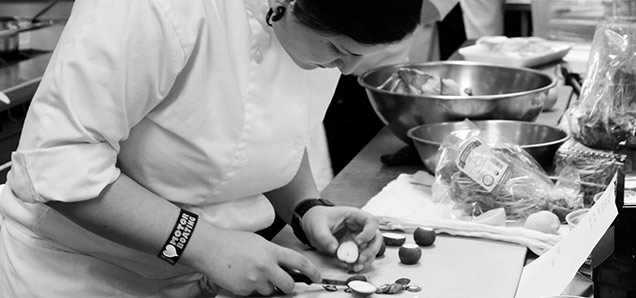Dishing out inspiration at Iron Chef competition
 CREDIT: MELANIE ANDERSON
CREDIT: MELANIE ANDERSONSaida Sayd slices up some radishes as part of her winning meal at Fanshawe�s first annual Iron Chef competition.
Fanshawe student Saida Sayd's family has been cooking for decades.
“My mom is a chef, her sister is a chef, her great-grandmother was a chef. For the longest time I wanted to be a lawyer, but I was drawn back — it's in my blood and it just happened and I love it,” she said.
When Sayd's Culinary Apprentice teachers mentioned Fanshawe's first-ever Iron Chef competition, she jumped on board with seven of her classmates. Each student was paired with a chef from a local restaurant.
“I was like, ‘I'm just going to go for it,'” she said. And it's a good thing she did.
Sayd won the competition with Robert Stewart from London's Petit Paris Creperie & Patisserie.
Each team was required to create a soup or salad, as well as an appetizer and entr�e. They had 30 minutes to come up with a menu plan using the available pantry items.
This created one of the biggest challenges. “Coming up with dishes on the fly, they've really only had about half an hour to think about their ingredients and what's available to them and now they've gotta create recipes from their head, be able to cook and go on the fly — so no organization, no preprep,” said Traci Jones, program coordinator in Fanshawe's School of Tourism and Hospitality.
They also had to incorporate the secret ingredient, Dead Elephant Ale (from Railway City Brewing in St. Thomas), into each of their dishes.
Using the secret ingredient creatively is what Sayd believes set her team apart from the competition. “We incorporated the secret ingredient the best, we showcased the beer instead of masking it; it was extremely bitter beer. It's really hard to make it palatable, something that's very harsh.”
Their creations consisted of a compound salad with sous-vide egg and beer dressing, a beer-marinated fried perch appetizer with vegetables and a side of greens, and for the main course a chicken dish. “We pounded out chicken and took some of it and threw it in the food processor and added some cream and spices, and then we rolled it and sous-vide it and then seared the outside. We butter poached the potatoes and cooked up some vegetables with that and made celery pur�e with beer and mushroom reduction.”
The judges awarded points for creativity, and looked closely at their technique, watching for proficiency in knife skills, cooking, carving, glazing and safe handling.
Jones is also on the executive council for The Canadian Association of Foodservice Professionals, who partnered the event, and was happy to help connect students with local chefs. “It's a great experience for the students because they get to network with professionals who are actually working in the industry. They're also taking direction from and learning teamwork; the two of them didn't know each other before — now the chef has to come in, the student has to come in and they have to build a relationship.”
For Sayd, the best part was working with Chef Stewart. “He is extremely organized and he's the biggest sweetheart ever ... There's no better way to get experience than to work with someone who has a lot of it and can teach you something,” she exclaimed.
Being half Russian and half Afghani, Sayd has been exposed to many different types of cuisines, and she never stops exploring. “I try to travel within Canada as much as I can. I've been to Vancouver, Montreal, and all over Ontario, just going to different restaurants and seeing plates and how much works goes into it, and it's just amazing.”













